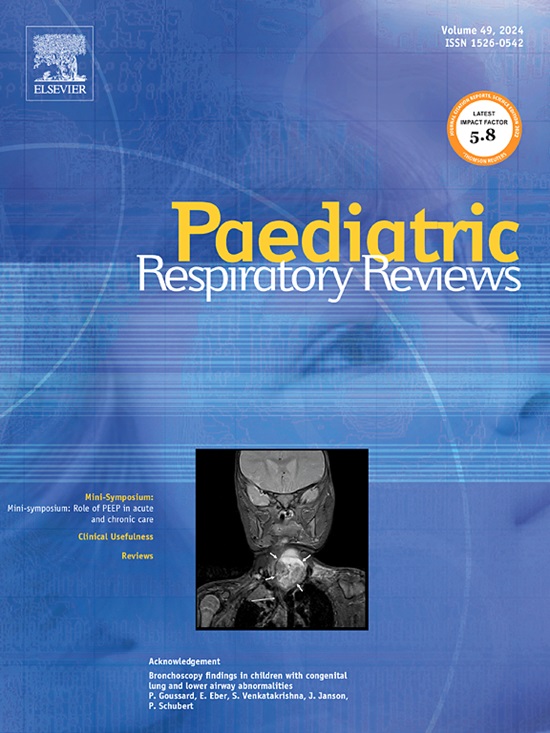Post-tuberculosis lung disease in children and adolescents: A scoping review of definitions, measuring tools, and research gaps
IF 4
3区 医学
Q1 PEDIATRICS
引用次数: 0
Abstract
Tuberculosis (TB) survivors, especially children and adolescents, can develop chronic respiratory problems called post-tuberculosis lung disease (PTLD). We conducted a scoping review to identify the current knowledge gaps on PTLD definitions, measuring tools, and research specific to this age group. We searched MEDLINE, EMBASE, Global Health, CINAHL, and Web of Science for studies published between January 1, 2000, and March 1, 2024, and identified 16 studies.
Our review found that no consistent definition of PTLD was used in the studies, and the measurement tools used varied widely. Moreover, there was a lack of research on children under five years old, who are disproportionately affected by TB. Also, symptom screening tools designed for adults were frequently used in these studies, raising concerns about their accuracy in detecting PTLD in children and adolescents.
Several critical research gaps require attention to improve our understanding and treatment of PTLD. Firstly, the use of inconsistent definitions of PTLD across studies makes it challenging to compare research findings and gain a clear understanding of the condition. Therefore, we need to include an objective measurement of respiratory health, such as a comprehensive post-TB lung function assessment for children and adolescents. It is also crucial to determine the optimal timing and frequency of post-TB assessments for effective PTLD detection. Furthermore, we need more knowledge of the modifiable risk factors for PTLD. The scarcity of prospective studies makes it difficult to establish causality and track the long-term course of the disease in children and adolescents. Finally, current approaches to PTLD management often fail to consider patient-reported outcomes and strategies for social support. Addressing these research gaps in future studies can improve our understanding and management of paediatric PTLD, leading to better long-term health outcomes for this vulnerable population.
儿童和青少年结核病后肺部疾病:对定义、测量工具和研究差距的范围审查
结核病(TB)幸存者,特别是儿童和青少年,可能会出现称为结核后肺病(PTLD)的慢性呼吸道问题。我们进行了范围审查,以确定当前在PTLD定义、测量工具和针对该年龄组的研究方面的知识差距。我们检索了MEDLINE, EMBASE, Global Health, CINAHL和Web of Science在2000年1月1日至2024年3月1日之间发表的研究,并确定了16项研究。我们的回顾发现,在研究中没有使用一致的PTLD定义,并且使用的测量工具差异很大。此外,缺乏对五岁以下儿童的研究,这些儿童受到结核病的影响不成比例。此外,在这些研究中经常使用为成人设计的症状筛查工具,这引起了人们对其在儿童和青少年中检测PTLD的准确性的担忧。需要注意几个关键的研究空白,以提高我们对PTLD的理解和治疗。首先,在不同的研究中使用不一致的PTLD定义使得比较研究结果和获得对该疾病的清晰理解具有挑战性。因此,我们需要包括呼吸健康的客观测量,例如对儿童和青少年进行全面的结核病后肺功能评估。确定结核病后评估的最佳时间和频率以有效发现PTLD也至关重要。此外,我们需要对PTLD可改变的危险因素有更多的了解。由于缺乏前瞻性研究,因此很难确定儿童和青少年的因果关系并追踪疾病的长期病程。最后,目前的PTLD管理方法往往未能考虑患者报告的结果和社会支持策略。在未来的研究中解决这些研究差距可以提高我们对儿科PTLD的理解和管理,从而为这一弱势群体带来更好的长期健康结果。
本文章由计算机程序翻译,如有差异,请以英文原文为准。
求助全文
约1分钟内获得全文
求助全文
来源期刊

Paediatric Respiratory Reviews
医学-呼吸系统
CiteScore
12.50
自引率
0.00%
发文量
40
审稿时长
23 days
期刊介绍:
Paediatric Respiratory Reviews offers authors the opportunity to submit their own editorials, educational reviews and short communications on topics relevant to paediatric respiratory medicine. These peer reviewed contributions will complement the commissioned reviews which will continue to form an integral part of the journal.
Subjects covered include:
• Epidemiology
• Immunology and cell biology
• Physiology
• Occupational disorders
• The role of allergens and pollutants
A particular emphasis is given to the recommendation of "best practice" for primary care physicians and paediatricians.
Paediatric Respiratory Reviews is aimed at general paediatricians but it should also be read by specialist paediatric physicians and nurses, respiratory physicians and general practitioners.
It is a journal for those who are busy and do not have time to read systematically through literature, but who need to stay up to date in the field of paediatric respiratory and sleep medicine.
 求助内容:
求助内容: 应助结果提醒方式:
应助结果提醒方式:


